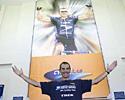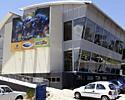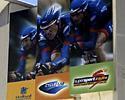
Recently on Cyclingnews.com |
CycleLab: putting bums on saddles indoors and out
The boom in indoor fitness cycling - 'spinning' - hasn't exactly benefited the outdoor cycling world, perhaps because the two varieties never see each other. South Africa's CycleLab bridges this culture gap by bringing every form of cycling under one roof, as Gabriella Ekstrom discovered. South Africa also hosts the world's largest mass-participation cycling events, attracting up to 35,000 riders, so while it may not be a major player in the pro scene, on the local front it enjoys great popularity.
 |
Serious cyclists may scoff at the sight of a room of sweating people sitting on poorly-fitted stationary bicycles with a neon-clothed instructor referring to French mountains every time they get up from the saddle. However, these people are halfway to becoming serious cyclists and one of the challenges which faces cycling administrators around the world is to put these fitness fanatics on to bicycles that actually go down the road.
Former professional cyclist Andrew McLean believes he has found the answer. Based in South Africa, his CycleLab "is the world's first cycling lifestyle centre that combines all aspects of the sport under one roof. We have indoor cycling both for amateurs and professionals, a retail range where we offer full support to the customer; masseurs, dieticians, and we can offer body assessments."
 |
The indoor cycling, called Lab Cycling, consists of three giant studios with spinning bikes, loudspeaker systems and a cinema-sized screen showing stages of the big tours to encourage the exercising riders. If your position is too critical to be altered, you are welcome to bring your own bike and do the session on rollers or indoor trainers instead.
"The goal of the Lab is simply to put bums on bicycle saddles, indoors as well as outdoors. We care for cyclists of all ability levels, regardless of their physical condition, gender or age." Andrew declares.
 |
Andrew's interest in cycling started while studying physical education at university, where he had to do a triathlon. From there he went on to do the Iron Man triathlon.
But he did not enjoy the running, so decided to specialise in cycling, and excelled in it. After only nine months as an amateur he won the SA national championships and turned professional. In brief, Andrew describes his cycling career: "I won almost all the major tours and one day events in SA, and I spent a few months every year based in Belgium."
After the All Africa Games Andrew came down with an illness and could not race for six months and decided to earn some extra money training cyclists.
"I have always been very interested scientific training and doing things 100 percent to get the best possible results.
"I started to train the riders in my garage, but eventually my neighbours moaned so much I had to move to bigger premises where I added a small retail element. Space quickly became an issue, and with cycling growing as a sport very rapidly in SA, I decided that we needed a bigger premises. We moved to Paulshof in July 1997. It was at the new branch that things really began to grow. We expanded upon our retail sector, offered more spinning classes and "pro training classes", and generally embarked on growing the CycleLab brand. It was also around this time that CycleLab began to have a cyber presence. We partnered with Super Sport, and made other strategic alliances in order to grow the brand."
 |
"Cycling in SA continued to grow at speed, and once again space was becoming an issue. It was also decided that the way forward for the business was to grow the lifestyle component of the sport, and to gather all areas of the business under one roof. We embarked on the building of CycleLab Nicol Grove - the World's First Cycling Lifestyle Centre!"
Andrew thinks that the concept has been welcomed, both by professionals and by those who are riding a bicycle just for the sake of their own fitness.
"There always existed a need within SA cycling for a major player to encompass what all the minor ones were offering and to consolidate all these services under one roof. At the time when I started the Lab, there was no one else doing exactly what I was doing. The goal was originally to just help cyclists improve their riding abilities. This goal very quickly shifted to one of bringing the sport to the people."
"I think the fact that we cover all aspects of cycling and all levels of ability mean that we always have quite a mix of riders around. Our cycling club, launched in February '01, gives these riders a base from which to leave for their rides. It really is a win-win situation. The pro guys have the opportunity to gain exposure for themselves and their team, and the other riders have an opportunity to learn from the pros. I think that the cycling community as a whole is appreciative of what we do. As for the non-cycling community, well we hope it won't be too long until they too decide to buy their own bicycles. "
 |
One area of the Lab is dedicated to South African racing, something that other countries usually leave to the local clubs or to the cycling federation. Andrew explains that they provide the race organisers a solution where cyclists are able to enter races online or manually. Once the entries have been done, they also offer a seeding for the event, through the use of their own national seeding system. Cyclists are categorised according to previous results, and sent off in batches accordingly. To get the race numbers to the individual riders, CycleLab is used as the collection point for many of the races.
Cycling shops in general don't offer these kind of facilities, but in Andrew's opinion, they have everything to gain by offering extended services.
"I think there is plenty of room for growth within the sport, and the number of riders doing races in South Africa, 135,000 or thereabouts, will continue to grow. What I think we need to see more of is a move away from single-track bike shops, offering bikes and accessories. The key is to examine the sport as a lifestyle, and to offer people an easy way into this lifestyle. People do not just start riding for no reason. There has to be a push from somewhere. Bike shops need to be able to be seen as almost a community project to get people together. Similarly, fitness institutions need to be geared to offer more than an indoor training facility. I think our success can be attributed to the right staff, projecting the right atmosphere within the right circumstance and surroundings."
Getting assessed
 |
We asked CycleLab staffer Nathalie Hobbs to guide us through the Lab's procedure for assessing and assisting a new rider.
Nathalie told us, "Each new member that joins the club (either as a pro training member or as a spinning member) receives an assessment voucher that is included in the joining fee. The objective of this being that we can assess the member's fitness level before they start training with CycleLab. They are the welcome to come back a few months later to be reassessed, so as to check if there has been an improvement - both in their fitness and weight loss. The women are more interested in lowering their fat percentages and toning their bodies whereas the men are more interested in improving fitness so that they can perform and achieve better times in the races. Although they may not be pro, many of the cyclists belonging to the club are very serious about their riding. The assessment is therefore a tool through which they can keep track of their individual progress.
"Generally, there are two types of assessments - a pro base and a spinning assessment. The pro base is a physically taxing test, which pushes the rider to his absolute limit of endurance. We set the rider up on his own bike and do tests such as lactate threshold, power output, VO2 max and flexibility. This assessment generally takes about an hour and a half and by the time the rider has completed it his legs feel like jelly. The spinning assessment isn't as taxing, we set the rider up on a spinning bike and generally test their endurance and cardiovascular fitness by making them ride for about 20 minutes (10 minutes warm-up at 65- 70 percent of their maximum heart rates, three by three minutes sets at 80-85 percent of their maximum heart rate, and a two minute warm down). Both assessments are heart rate monitor based. Also, in both assessments we check the riders blood pressure, pulse, body weight, fat percentages, BMI and BMR. We use specialized equipment and computers for these tests.
"At the end of the assessment, we are able to print out various graphs that relate heart rate to cadence and these are good indicators of the rider's cardiovascular fitness and endurance. We then give the member a full explanation of what all the results were, as well as tips they can use to further improve their cycling. This info is given to them to keep so that the next time they come for an assessment we can look back and compare."
